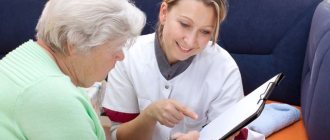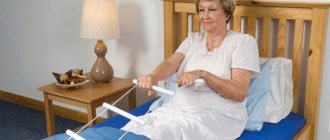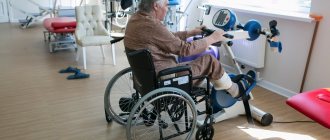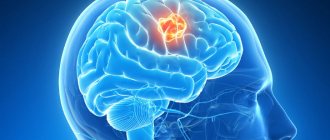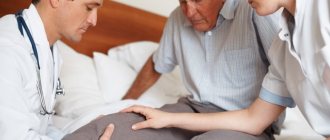Stroke is an acute disorder of cerebral circulation that causes focal damage to brain cells. The disease has typical neurological symptoms that persist for a long time: painful headaches, paresis or paralysis of the facial muscles or limbs (often one-sided), impaired memory, speech, vision, and coordination of movements.
In the elderly, and especially in old age, strokes are much more severe and pose a direct threat to a person’s life. Whether a patient will be able to return to a full life after suffering a stroke or at least partially restore lost skills depends on a number of factors. In any case, this is a long process, taking months and sometimes years.
Factors influencing recovery time after stroke
Stroke is one of the main causes of disability in old age, most often occurring as a result of untimely medical care or lack of competent rehabilitation. In 80% of cases, the success of recovery after a stroke is determined by the prompt action of medical staff. It is especially important to provide assistance in the first 3-4 hours after the onset of an attack. Rehabilitation must begin as early as possible, because the quality and duration of a person’s future life depend on it.
Other factors also influence the timing of rehabilitation after a stroke:
- The mechanism of stroke. There are 2 main types of strokes – ischemic and hemorrhagic. Ischemic occurs in 80% of cases and is caused by a lack of blood supply to any part of the brain. With this type of stroke, if treatment is prescribed correctly and on time, the body has a good chance of recovery. Hemorrhagic stroke is characterized by bleeding into the deep parts of the brain. The life prognosis is unfavorable, the probability of death reaches 50-70%.
- The degree of damage to brain tissue. The most serious violations of the basic functions of the body are observed with an extensive stroke affecting large areas of the cerebral cortex. In this case, if the person managed to survive, rehabilitation may take several years, and full recovery may never occur.
- Age and presence of concomitant diseases. The older a person is, the more difficult it is for him to cope with a blow, and in the presence of chronic diseases, especially the cardiovascular system, this often becomes impossible.
- What a seizure. Repeated strokes always increase the risk of death. While it takes an average of 8 months for an elderly person to recover from the first blow, it can take a year or more to recover from the second.
- Psycho-emotional state of the patient. In order to cope with such a serious illness, enormous willpower and desire to live are required, which not every patient has.
Long-term rehabilitation
The duration of rehabilitation measures is not limited in time. Because, due to individual characteristics and the degree of damage, on average, the restoration of lost skills occurs after 3 years. This time is enough for patients to adapt to new living conditions. And for relatives - to improve their daily life and resolve issues regarding care.
At the same time, patients are able to learn small everyday movements: pouring water into a cup, turning the key in the lock, etc. Some patients may receive a new specialty to work from home.
Periods of rehabilitation after a stroke
Modern medicine recommends starting rehabilitation of a patient who has suffered a stroke in the first hours after the attack, as soon as hemodynamic parameters (heart rate, blood pressure) return to normal. This allows not only to restore lost functions as much as possible, but also to avoid various complications that can aggravate the patient’s condition.
The recovery period can be divided into several main stages:
- acute (first 3-4 weeks after the attack);
- early recovery (first 6 months after an attack);
- late recovery (from 6 months to a year);
- remote (more than a year).
Contraindications
Rehabilitation is contraindicated in the following cases:
- the patient is in a coma;
- pronounced aggressive behavior caused by mental disorders;
- recurrent stroke in old age;
- severe diabetes mellitus;
- convulsive syndrome;
- tuberculosis;
- malignant neoplasm.
The likelihood of a full recovery after a stroke is low, but you shouldn’t give up. Accurate adherence to medical recommendations will allow you to achieve better results.
Acute stage of the disease
Rehabilitation in the acute period takes place in a medical institution under the guidance of doctors. It is advisable to begin rehabilitation treatment as soon as the patient’s condition stabilizes, optimally 3-4 days after the stroke. The main tasks at this stage are: restoration of simple motor and speech functions, prevention of complications and relapses, assessment of the degree of damage to the body and development of a rehabilitation program.
To restore the motor system, passive gymnastics, massage and treatment by changing body position are used, when the patient’s limbs are placed in various positions to prevent the development of muscle hypertonicity. The return of lost speech skills begins with simple articulation exercises, gymnastics of the tongue, cheeks, and lips. Speech is more actively restored 3-6 months after a stroke, but full recovery requires 2-3 years of work with the patient.
An important condition that accelerates rehabilitation in the acute period is the use of medications and physiotherapeutic pain-relieving procedures - magnetic, electro- and laser therapy.
Diet of a patient who has suffered an ischemic stroke
Since the leading cause of ischemic stroke is atherosclerosis, which affects the vessels responsible for the blood supply to the brain, the diet after a stroke should help prevent further progression of atherosclerosis.
- Strong meat broths, high-fat dairy products.
- It is necessary to reduce the consumption of cholesterol, which is found in large quantities in butter and animal fats.
- It is recommended to exclude fatty meats (primarily pork) from the diet.
- Reduce salt intake to 3-5 grams per day.
The basis of the diet of a person who has suffered a stroke should be foods containing large amounts of fiber and complex hydrocarbons. First of all, these are fresh fruits and vegetables.
Regular consumption of foods containing polyunsaturated fatty acids can reduce blood cholesterol levels and, accordingly, reduce the risk of developing a recurrent stroke:
- Liquid vegetable oil,
- Seafood,
- Fish.
Recommended to eat:
- Boiled and baked lean meats,
- Low-fat dairy products,
- Wholemeal bread,
- Bread with bran.
In the first days after a stroke, boiled food is better absorbed. Preferably in pureed form.
Rehabilitation after stroke in the early recovery period
The early recovery stage is crucial for the patient and should ideally take place in a sanatorium or rehabilitation center. When deciding to leave the victim at home, you should remember that successful recovery after a stroke is impossible without the active participation of specialized specialists who will have to be invited to the home.
The first three months after the onset of the disease are especially productive and favorable for rehabilitation. At this stage, they move from the simplest exercises to more complex ones - they teach a person to roll over, rise, sit down, and stand up independently. Next, elements of active physical therapy are gradually introduced, physiotherapy, massage, speech work are continued, and complexes are performed to restore vision and eye movements, cognitive functions (memory, thinking, attention).
A common consequence of a stroke is complete or partial loss of vision, dysfunction of the eyelid, presbyopia, when a person cannot distinguish small print or small objects at close range. All these disorders require qualified assistance from an ophthalmologist, who will prescribe either medication or surgical treatment. In mild cases, they can do with therapeutic exercises for the eyes.
To restore attention, memory, and intellectual abilities, there are many exercises: memorization tasks, memorizing poetry, solving riddles, rebuses, putting together puzzles, chess, checkers. However, for complete rehabilitation of cognitive functions, psychological and correctional classes are necessary individually or in groups. Additional stimulation is provided by medications that should be prescribed by a doctor.
Late and remote periods
At a later stage, the body’s potential for rehabilitation after a stroke gradually decreases, but the patient must continue to study and train self-care skills. This period already passes at home, so responsibility for the health and mental state of the patient falls entirely on his loved ones.
You can change your usual exercise therapy complex by adding new exercises and classes with simple exercise equipment, for example, an expander. It is recommended to talk with the patient as often as possible, ask questions, thereby encouraging him to be vocal.
A year after the stroke, the exercises no longer have a pronounced effect, so in the long-term recovery period, the main attention should be paid to consolidating skills and periodic visits to the doctor for follow-up examinations.
Conditions for successful rehabilitation after a stroke
A stroke is a difficult ordeal, especially for older people, who can suffer from it with unpredictable consequences. How long it will take to recover - even doctors cannot answer this question for sure. But in order to shorten the rehabilitation period after a stroke, the patient must provide a number of conditions:
- rehabilitation should take place under the strict guidance of a qualified doctor according to an individually developed program;
- the rehabilitation process must be continuous and comprehensive. This means that it is necessary to work on restoring all body functions simultaneously and sequentially;
- in the home environment, it is necessary to create all the conditions for the successful rehabilitation of the patient: equip the sleeping place with an anti-decubitus mattress, allocate a place for doing therapeutic exercises and purchase the necessary exercise equipment, as well as additional equipment - walkers, wheelchairs, canes, special personal hygiene products;
- provide a balanced diet throughout the entire period of rehabilitation;
- take care to create a favorable home atmosphere, sensitive and caring attitude towards the sick person.
Relearn to speak, eat, understand and remember
— How should you prepare a home for a patient after a stroke? And what additional equipment will he need?
— While the patient is regaining the daily skills necessary to independently care for himself, while he has difficulty moving, it is necessary to ensure that he can move safely. For this:
- remove carpets and wires on the floor to prevent the patient from tripping. Make sure all paths the patient uses are clear and well lit.
- equip the bed with rails so he can sit down
- in the bathroom, attach special vertical railings that the patient can hold on to,
Special devices - a toilet chair, a bath seat - will make the patient’s life easier at home.
- install a seat in the bathtub or shower so that the patient can wash while sitting,
- raise the height of the toilet using a bedside chair,
- when the patient learns to walk, buy him a walker, and later a cane.
about possible contraindications, consult a specialist
— After a stroke, people often have speech impairments. Can it be restored?
— Yes, articulation gymnastics, which I mentioned above, as well as classes with a speech therapist, help restore speech functions, but the main thing is communication with loved ones, that is, daily speech practice. Speech disorders can be of two types - aphasia (the patient has difficulty understanding words and expressing his thoughts) and dysarthria (there is understanding, but pronunciation and fluency and clarity of speech are impaired). General rules:
- Ask questions that the patient can answer “yes” or “no.”
- speak slowly and clearly, give the patient time to respond, do not speak for him.
- be patient and consistent. With regular exercise, improvement will definitely come over time.
— What should a person be fed after a stroke?
- Patients with stroke often have a problem with impaired swallowing - dysphagia, and there is a risk of obstruction of the esophagus and aspiration (penetration of foreign bodies into the lungs). It can cause suffocation, infectious diseases, and pneumonia. Such patients need to be fed, strictly following the recommendations: only in a sitting position with support under their back, turning to the healthy side at the time of swallowing, only with a small amount of food.
Semi-hard foods are best tolerated - casserole, thick yogurt, pureed vegetables and fruits, watery porridge.
Give solid and liquid foods at different times. Eliminate from your diet foods that often cause choking - bread, cookies, nuts, etc.
— What other disorders does a stroke lead to?
— During a stroke, areas of the brain that are responsible for the processes of learning, understanding, and communication can be damaged. Memory deterioration and problems with perception are often observed: a person does not realize that the functions of his body are impaired, he does not recognize familiar objects or people, he may ignore some part of the body. Over time, with proper therapy, lost skills will be restored, but this is a slow process.
At home, you can and should exercise your memory and attention: ask the patient about what he did/saw yesterday, look at a family album, solve riddles, remember similar objects by shape, color, etc.
Another important point is the patient’s mood. A person experiences despondency, emptiness and hopelessness due to the fact that he cannot fulfill his previous social functions (work, take care of his family), a feeling of humiliation due to lost basic skills, and may refuse to communicate. Sudden mood swings, aggression, anger, laughter and tears for no reason are possible.
In such cases, the patient may need treatment with antidepressants, and relatives may need to be calm and refrain from criticism.
Both the patient and his family need to remember that all of these are consequences of a stroke, which will go away as they recover.
about possible contraindications, consult a specialist
Where to go for help?
It is impossible to provide complete rehabilitation after a stroke in the home environment. Therefore, the most reasonable option for the family of an elderly person who has suffered an attack would be to enter into an agreement with a specialized institution, where he can receive help from highly qualified specialists and undergo a comprehensive rehabilitation program developed taking into account his diagnosis and characteristics of the body.
The Trust boarding house network has been providing care and rehabilitation to stroke victims for the past 5 years. The staff consists of highly qualified doctors and nurses with medical education. The boarding houses have all the conditions for a comfortable stay and full recovery after a stroke:
- Individual rehabilitation programs aimed at adaptation after a stroke and prevention of a recurrent attack.
- Regular medical examination of the patient.
- A full range of rehabilitation procedures: exercise therapy classes, exercises for the rehabilitation of speech and cognitive functions.
- Drug therapy.
- Social and psychological assistance, warm and attentive attitude towards each ward.
- Cozy rooms equipped with functional beds, wheelchairs, orthopedic mattresses.
- Prevention of bedsores and daily hygiene.
- Specialized 6 meals a day, rich in vitamins and microelements.
- Organization of leisure and communication.
By entrusting us with the care of your loved ones, you create decent conditions for life and restoration of their health, thereby reducing the recovery time after a stroke. To find out more details about our programs, leave a request on the website, and we will call you back at a time convenient for you.
